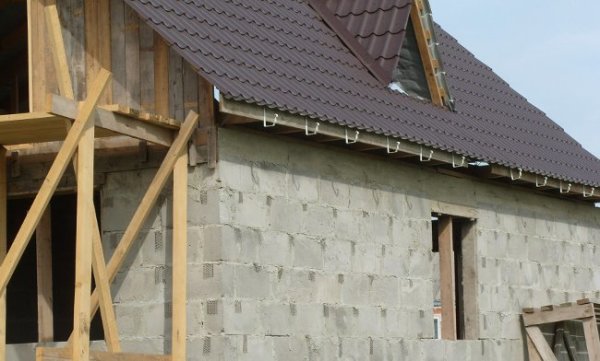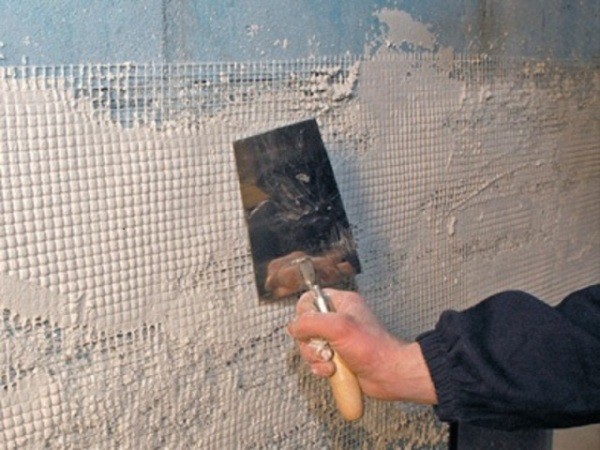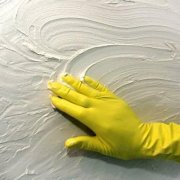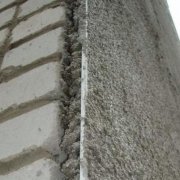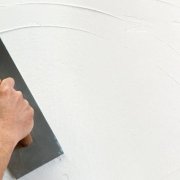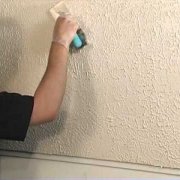Let's consider how to plaster foam concrete blocks
Foam block plastering is a rather laborious process. After all, this material quickly absorbs moisture from the solution. Foam plastering requires certain skills.
How to plaster foam blocks and how to do it, we will tell today. After watching the video in this article, you can see and understand everything, then it will be easier for you to do this job.
The content of the article
Correct work
How to plaster foam blocks, you need to decide from the very beginning. If you need facade plaster for foam blocks then the cement composition is perfect. It tolerates temperature extremes and high humidity. If you need to do the interior decoration, then lime compositions will do.
They are easier to apply and they retain heat better. All the work can be completely done with your own hands, then the price of finishing will be much lower. But here you need the right approach, the instructions below will tell you everything in stages.
The solution to the problem of poor adhesion
The foam block is a rather capricious building material that interacts differently with plaster compositions. Not every mixture of sand and cement induced in the stand-by trough will be necessary for a high-quality finish.
The mass may not hold well, especially on surfaces that have significant vertical or horizontal deviations, and if necessary alignment with a layer with a thickness of more than 5 centimeters. There are two excellent, relatively inexpensive methods to increase surface adhesion (susceptibility to retention of the stucco composition due to the mutual penetration of materials into each other).
So:
- Apply a primer to the foam concrete surfaceconcrete contact (see Concrete contact - primer for surface preparation) and other special compounds;
- Reinforcement mesh fastening. To do this, you can use either a special grid for plaster, bought at a hardware store, or a regular nylon net for fishing with cells no more than 5-6 cm.
In the absence of work on preparing the surface using these methods, you can follow the path of the plaster stratification and carry it out in three stages: spraying the liquid layer, performing the base and coating.
Attention: Between each step, it is imperative to provide for time so that the previous layer is completely dry. Foam concrete surfaces should be moistened first before applying the stucco mixture. For the widespread penetration of water into the cells of the material, it is desirable to use a spray gun.
Characteristic properties of solutions
For plastering foam blocks, a special lightweight plaster is required, which has a number of properties:
- High elasticity;
- Steam conductivity;
- Good adhesion;
- Resistance to moisture and low temperatures.
Plaster for foam concrete is produced by most of the enterprises that are engaged in the production of dry building mixes. Among them we highlight the most popular representatives of the brands “Pobedit”, “Ivsil”, “EuroMix”. This product is very convenient to use: it is easily diluted with water to the required consistency.
Attention: The plastering of walls made of foam concrete, rooms with high humidity is made by moisture-resistant compounds based on cement. In addition, these same mixtures are used for plastering exterior walls.The walls of rooms operating in conditions of high humidity are pre-prepared with water-repellent compounds.
Plastering foam block walls
A house built of foam blocks is subject to heavy draft, so plastering work is done after it has been idle for a year or a year and a half. During this period, communications are laid: water supply networks, plumbing devices, electrical wiring.
So:
- Plaster foam surfaces should be plastered using a cord and level. In addition, the walls should be inspected for the presence of uneven surfaces, usually protrusions. The recesses are closed with plaster, and the protrusions interfere with the quality of the plastering work.
- The layer must be applied with a thickness of not more than 15 millimeters. Otherwise, there may be a chance that the applied layer will fall off under its own weight. To facilitate the execution of work and improve quality, the reinforcing mesh is fixed with nails or quickly hardening compound - gypsum or alabaster.
- Apply a waterproofing layer with a brush or roller. Keep in mind that a foam block house is allowed to be plastered from the outside only after interior decoration has been completed.
- A very important point is the control over the placement of the solution both externally and internally. The thickness of the plaster on the inner walls should be twice the thickness of the outer wall layer. The greatest possible difference is if the layer on the outer surface is within 5 - 10 mm, and on the inner - 10 - 20 mm.
- For a house built of foam concrete blocks, you do not need to apply a large layer of plaster. Foam block material has a high vapor permeability. The technology for manufacturing foam blocks should be considered.
- If the foam block was molded, the top layer will pass moisture poorly. Before laying the walls, the blocks are first cleaned by removing the top layer. If the blocks were subject to cutting, then preliminary preparation is not necessary.
Caution: Before applying the plaster, always apply a primer coating. This will greatly enhance the adhesion of surfaces.
The sequence of plastering foam blocks
Choose mixtures designed for processing foam blocks, which contain reinforcing fibers and additives. Self-made mixtures can provoke a large number of errors, for example, stains on the walls.
So:
- Use formulations with high adhesion. As practice has shown, in addition to special mixtures, gypsum-based compounds, for example, Rotgips, have also shown good results.
- The surface to be treated must be dust free. Take a look at the oil stains. Clay is used to get rid of such stains. First, it is applied to the stain, then after the clay has dried, the stains are removed.
- If this is not enough, the stain must be removed with a grinder and stone on concrete, after which they close up with a mixture.
- For the implementation of high-quality plaster, you need to use a deep penetration primer.
- Fix the beacons or reinforcing mesh for laying the plaster. To do this, make holes with a perforator and then hang a grid on the screw head.
- Spray water onto the wall. Trowel the mortar onto the wall with a trowel.
- After filling the entire wall, use the rule to level the solution, removing excess and introducing them into empty areas.
- In the corners, use the level to set the mounting profile for even angles. Along the installed element, apply the solution, and after drying, remove the profile.
- Remove excess mixture after it hardens a little, then it will not float and will easily be subject to adjustment. But do not expect complete drying out, otherwise it will be difficult to get rid of irregularities.
- After the walls have completely dried, clean them with a rule, use a spatula to remove small lumps of dried mortar and do the finishing.
How to plaster foam blocks outside and how to do it, you know. Stuccoing on foam blocks is not a complicated process, but painstaking. Remember that the correct preparation of the base plane is of great importance here. Therefore, take your time, look at the photo and determine the order of work correctly. Then you can do everything qualitatively.
